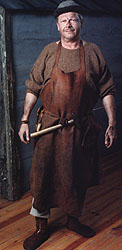Meet the Middle Ages
BackFarmers who produced iron

The peasants of the Emå Valley made a living from growing crops and keeping livestock. They had fields where they grew barley, rye and flax. In the forests, the land was much poorer. The farmers there tried to live off their small plots of land and their herds of cattle, but they had to have some additional sources of income. These were forestry, charcoal-burning, tar-making and the production of iron. In the woods, a lot of iron was produced in the 13th and 14th centuries. The regions of Madesjö-Bäckebo and Gullabo-Karlslunda were the largest iron-producing districts of northern Europe at this time. Handbörd also had an impressive production of iron. There was a master smith named Veland in the parish of Fagerhult. This skilful smith was named after Volund, an expert smith from the Scandinavian epic "Volunderkvida". It must have been quite something, to be named after such a hero! We can probably assume that the iron-ore and the skills of the smiths were of a very high quality here.
The iron would be loaded on horses or carts and taken to Kalmar. From this port, a great deal of iron was shipped to Germany.
We call the farmers who produced iron "iron-farmers". You can find evidence of their existence because remnants of their production of iron – "slag-heaps" – are still to be found in the woods of Handbörd.
Read more about the production of iron in "Meet the Middle Ages", Life in the country-side, Work